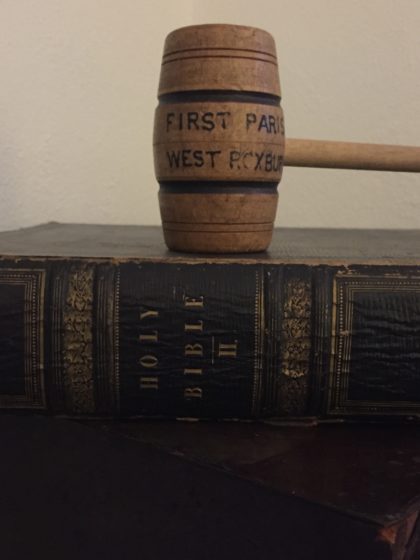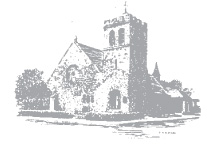Our Own Story
The English settlers of Massachusetts Bay brought with them the conviction that each independent settlement should have its own church, Puritan in its principles, observances, and governance. Settled in 1630, the town of Roxbury had such a church.
In 1706, 45 inhabitants of the western end of Roxbury, a distance of about six miles over very rough and sometimes impassable roads, petitioned the General Court to form another parish. The request was ignored.
Not waiting for permission, the petitioners built a meetinghouse by April 1711 just off Walter Street on Peter’s Hill in what is now the Arnold Arboretum. Thirty-two men were called before the Roxbury town meeting to publicly apologize to their “mother church” and the town for their forwardness. Subsequently, 18 were released from their responsibility to the First Parish in order to form the Second Church of Roxbury. On November 2, 1712, the new church held its initial worship service with the First Parish Church minister, the Rev. Nehemiah Walter. Three weeks later, the Second Church called its first minister, the Rev. Ebenezer Thayer, to the pulpit.
Evolution to More Liberal Theology
The formerly Puritan congregation had gradually moved to the more liberal religious theology of Unitarianism. When its covenant was rewritten in 1832, a number of members withdrew to found the South Evangelical Church in 1836. This church, later renamed the West Roxbury Congregational Church, joined the Baptist Church in 1977 to form the Stratford Street United Church.
Theodore Parker’s Ministry Transforms the Church
 In 1837, Second Parish of Roxbury called to its pulpit Rev. Theodore Parker, a young scholar just out of Harvard Divinity School and newly wed to Lydia Cabot. His evolution from traditional Unitarian theologian to important spokesman for Transcendentalist thought and a growing supporter of social reform took place in West Roxbury. His parishioners and members of the Brook Farm Institute of Agriculture and Education, a utopian community on nearby Baker St., influenced this transformation. His congregation loved and supported him during his later banishment from the Boston Unitarian brotherhood for his radical theology. In 1846, he was called by a circle of men to serve a church created “so that the people of Boston could hear him.” West Roxbury sadly, but with continued good wishes, bid him goodbye. The meetinghouse on Church Street was called “Theodore Parker’s church” well into the 20th century.
In 1837, Second Parish of Roxbury called to its pulpit Rev. Theodore Parker, a young scholar just out of Harvard Divinity School and newly wed to Lydia Cabot. His evolution from traditional Unitarian theologian to important spokesman for Transcendentalist thought and a growing supporter of social reform took place in West Roxbury. His parishioners and members of the Brook Farm Institute of Agriculture and Education, a utopian community on nearby Baker St., influenced this transformation. His congregation loved and supported him during his later banishment from the Boston Unitarian brotherhood for his radical theology. In 1846, he was called by a circle of men to serve a church created “so that the people of Boston could hear him.” West Roxbury sadly, but with continued good wishes, bid him goodbye. The meetinghouse on Church Street was called “Theodore Parker’s church” well into the 20th century.
The legislature officially changed the church’s name to the First Parish of West Roxbury when the town seceded from Roxbury in 1854. When Boston annexed West Roxbury in 1874, the church retained its name.

A Split, a Fire, and Another New Meetinghouse
In the later years of the 19th century, as West Roxbury and Roslindale were becoming suburban communities, the church was isolated outside the boundaries of either town. Discontent grew: some wanted to move to the center of West Roxbury; some were dissatisfied with their minister of 20 years; a third group wanted to stay where they were, because of the sylvan location and the historical link to Theodore Parker.
On January 22, 1890, a fire listed as “incendiary” in fire department records of the time decided the issue. A Roslindale contingent, with the minister, moved to Roslindale, building the Roslindale Unitarian Church on South Street in 1892. The remainder of the congregation took the First Parish of West Roxbury name, the church silver, and the Theodore Parker connection, and built a new meetinghouse on Corey Street.
Decline and Rebirth, 1950 to the Present
Both congregations thrived until their communities again began to change. With the movement of residents to the outer suburbs in the 1950s, their memberships dwindled until it became clear that neither church could survive on its own. In 1962, the combined congregations merged and chose the name Theodore Parker Unitarian Church. However the congregation continued to struggle. In 1976, parishioners were presented with three offers to buy the buildings. Courageously, they declined all three by a vote of 18 to six.
Beginning in the 1980s, a group of energized young adults, led first by the Rev. Richard Kimball and then the Rev. Robert Haney, envisioned new possibilities for the church. The buildings, long neglected, were recognized in 1985 by the Boston Landmarks Commission due to the church’s role in the history of West Roxbury, the significance of the buildings’ architects, and the splendor of its Tiffany windows. Several grants have been awarded to bring the church back to its former beauty.
In 1993, the parishioners voted to remove the large Christian cross in the sanctuary. This decision reaffirmed the church’s historically liberal theological roots and has helped to create a diverse, liberal, and welcoming community and a spiritual home for area families and residents looking for such a church.
As the community has changed in the past three centuries, so too Theodore Parker Church has continued to grow and evolve. May we joyfully celebrate our history, honoring the rich legacy left us by our spiritual forebears, while also rededicating ourselves to the mission of providing sound, beautiful buildings and a welcoming home to a diverse array of seekers.

